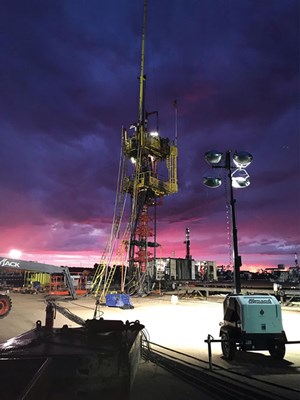Implementation of Hydraulic Completion Units (HCUs) in the Permian basin: A new innovative completion technology
Wells in the Permian basin continue to increase in technical complexity and lateral length, testing the limits of traditional completion practices in unconventional wells. Coiled tubing has been the standard method for drilling out frac plugs in the basin, but it has mechanical limitations in extended-reach and high-pressure laterals.
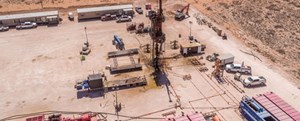
Due to the increasing well complexity, operators have begun using new hydraulic completion unit (HCU) technology, also known as a snubbing unit, to drill-out frac plugs in certain Permian basin wells. By using HCUs in wells with longer laterals, higher pressures, and downhole uncertainty/complexity, some of the additional risks can be mitigated. Lateral sections in Permian wells often exceed 10,000 ft in certain fields. The increased lateral length is a significant accomplishment; however, it comes with its own complications.
In the effort to find a solution for effective clean-outs in these longer laterals, an HCU field trial was implemented. Through field trials and case history data, the HCU has proven to be a more reliable, cost-effective method to clean out laterals in some fields in the Permian basin while reducing mechanical risk and ultimately improving the probability of a project’s success. The information contained in this article originated in SPE paper 201412 and can be downloaded in OnePetro.
SNUBBING / HCU HISTORY
Coiled tubing and snubbing units have been used for decades in onshore and offshore applications. Both provide a means to safely enter and exit a pressurized well in a controlled manner. Before the horizontal well shale boom, snubbing units were applied for situations including wellbore cleanouts, workovers, well integrity issues, plug and abandonment, fishing, blowout, remedial cementing, restimulation, and running production tubing with or without artificial lift.
Snubbing units typically use 23/8-in. or 27/8-in. jointed tubing (stick pipe) and require a power tong to make connections. The advantages of using stick pipe include the ability to rotate the tubing string and apply higher forces moving in and out of the well. Coupled with rotation, stick pipe can also achieve higher annular velocities that improves hole cleaning.
While a CTU can be used as a stand-alone system, snubbing units historically required a service rig to run and retrieve tubing. However, the stand-alone HCU has been developed and refined over the past five years and will be discussed in this article. Both CTUs and snubbing units require similar auxiliary systems such as pumps, fluids, back pressure valves, motors, and bits to allow circulation, but prevent backflow up the tubing when not pumping.
Longer laterals. The North American shale industry has evolved, and operators have pushed the envelope to drill longer laterals, aiming to improve returns and well economics. Lateral lengths of 5,000 to 7,500 ft were common between 2005 and 2016, with the exception of the Bakken, where laterals often exceeded 9,000 ft. Operators in the Marcellus shale led the way in extended-reach laterals, drilling 9,000-to-12,000-ft laterals starting in 2012. Today, other basins, such as the Permian and Eagle Ford, have followed suit, and operators are drilling extended-reach laterals exceeding 10,000 ft to rival the Marcellus.
SNUBBING 101
A snubbing unit is used when pressure is expected at the surface, and the operator does not plan on “killing” the well. Pressure in the well creates a force against the cross-sectional area of the tubing, as it is being run into and pulled out of the well. The tubing contains dual back pressure valves to prevent flow up in the tubing, so the entire cross-sectional area is exposed to the upward force.
When moving tubing into and out of a pressurized well, slips are used to hold onto the pipe. The modern HCU systems have 4 sets of slips: two sets of snubbing slips control pipe during pipe light operations and two sets of heavy slips control pipe during pipe-heavy operations. Once the slips bite the pipe, a hydraulic jack is used to move the pipe into or out of the well. The process is relatively fast and consists of one set of slips biting the pipe, the other set opening, the jack moving the pipe about 10 ft, then the other slips grab the pipe again. And it is common to run 40 to 60 joints per hour, depending on well pressure.
Stripping. Snubbing units are able to move pipe into and out of the well without any pressurized fluid escaping. This process is called stripping, which is the act of moving pipe through a closed blowout preventer (BOP). The HCU contains an annular BOP (aka: bag) for lower-pressure operations and stripping pipe rams for higher-pressure situations.
In the event of a failure downhole, or at surface, there is additional well control equipment in place. Sitting on top of the frac valves and below the stripping BOPs are the primary BOPs. These typically include two or three sets of pipe rams in conjunction with a blind/shear ram. They are similar to those used on a drilling rig but are designed for smaller tubing sizes. The final set of safety devices is the profile nipples installed periodically throughout the tubing string. In the event of a check valve or tubing failure, wireline plugs can be run to isolate the problem.
RIG-ASSIST SNUBBING UNITS
For decades, the industry has used a combination workover service rig and a snubbing unit commonly referred to as a rig-assist or snub-assist for well interventions in vertical and horizontal wells. An advantage of a rig-assist package is its merging of two units into one. It can trip pipe, using the snubbing unit during pipe light and transition periods but quicken its trip time using the workover rig and its blocks during the pipe-heavy period.
Package limitations. A disadvantage of this package is that it requires the integration of two services to perform one operation. It is vital that both services have exceptional communication during the job. Additional challenges include power swivel limitations, a larger footprint required by the service rig, and an inability to provide the high torque requirement associated with extended laterals. The package’s typical footprint is greater than 100 ft in length, and it has a base beam that is 5 ft x 40ft, which can create difficulties in rigging up and down on multi-well pads with tight well spacing and infrastructure. This congestion on site introduces additional hazards and risks that should be mitigated.
STAND-ALONE RIG-LESS HYDRAULIC COMPLETION UNIT
The HCU eliminates the need for the service rig and consists of a stand-alone unit that mounts on the wellhead after the stimulation treatment is complete, as shown in Fig. 1. This design requires ~50% less pad space and roughly six truckloads to move onto location. After being assembled on the first well, the entire unit, including the primary BOPs, can be moved with a crane in a single lift from well to well, and can be fully rigged up within 4 to 5 hrs.
History in very long laterals. The HCU has demonstrated the ability to drill-out frac plugs successfully in seven of the longest laterals in North America and can rotate ~50 rpm in 20,000- ft laterals, depending on wellbore geometry. Typical operating parameters include a rotating speed between 40 and 70 rpm at under 4,000 ft-lbs of torque. Since 2008, the HCU has been used to drill-out frac plugs in over 3,000 laterals in U.S. shale plays. The system is rated for surface pressures up to 15,000 psi and can handle hookloads of 150,000 lb push and 300,000 lb pull.
The HCU typically uses 27/8-in. tubing with premium connections to carry a downhole motor, dual back pressure valves and a tri-cone drill bit. Occasionally, tapered strings are used when torque and drag modeling suggests it would be beneficial. The typical surface pressures for the Permian wells in this study ranged between 800 and 4,000 psi.
DRILL-OUT PROBLEMS
As lateral lengths increased in the Permian basin, challenges began to arise while drilling out frac plugs with a CTU. The first of which was the large increase in chemical usage, specifically pipe-on-pipe (POP) friction reducer. The amount of POP usage increased significantly over the last ~2,000 ft of a 10,000-ft lateral and accounts for the majority of POP used in the well. This POP friction reducer is one of the most expensive additives on location, so the more of it used, the faster the job cost increases. Xanthan gum, the chemical used to create viscous sweeps, accounts for another large chemical cost.
Since coiled tubing is unable to rotate, a cuttings bed forms on the low side of the wellbore. This creates additional friction between the coiled tubing and casing, which can lead to excessive pick-up weights, decreased ability to reach plug-back total depth (PBTD), and stuck pipe. To combat this, viscous sweeps are generally pumped after every plug and range in size from 5 to 10 bbl, in an attempt to circulate as much plug debris and sand out of the well as possible. Although the sweeps are effective in cleaning debris from the wellbore, a cuttings/sand bed remains. This is because heavier debris fall to the low side of the wellbore, and flow regime alone is not strong enough to keep it suspended in the lateral. The flow and sweeps end up traveling above the cuttings bed instead of transporting the debris up hole.
Cross-flow problems. Certain fields throughout the Permian basin have been developed more than others, which presents challenges. Some fields may have depleted “pockets,” due to past production in the area. These pockets present the potential for cross-flows, which can result in stuck pipe while drilling out frac plugs. These cross-flows, and the sticking issues associated with poor hole cleaning, have resulted in multiple instances of stuck coiled tubing. On several occasions, the stuck pipe has been pulled or worked free, but this has required extensive hours of non-productive time (NPT) to do so, incurring detrimental costs to the project.
In a few instances, the coiled tubing had to be cut, and the well worked over, to try and remove the stuck tubing. Fishing coiled tubing in the lateral is a difficult and costly task. Cutting the coiled tubing and rigging the unit down from location adds an additional five to seven days and is followed by a workover rig or HCU to fish the tubing. The fishing job described above requires several weeks of operations, and it is known that costs can easily surpass $1 million. While tangible costs are obvious, the cost of delayed production and breaks in schedule are also detrimental to a well’s economics. The additional costs of fishing coiled tubing have been removed from the data in this paper. All graphs and data do not include the additional time or money used to fish coiled tubing.
After the frac plugs have been drilled out, the CTU sets a production packer and moves off location. A workover unit then arrives on location shortly after the CTU leaves, rigs up, tests the BOPs, and runs in the hole with the production tubing and artificial lift. This work adds roughly two days per well and creates another internal hand-over between functions, which has potential for human error.
HCU IMPLEMENTATION RESULTS
An HCU was implemented in March 2019 to drill-out frac plugs in various fields of the Permian basin, in conjunction with CTUs. The following results are based on data from 2019, where +/-50 wells were drilled out using the HCU, and +/-125 wells were drilled out with a fleet of two to three CTUs.
Reduced chemical usage. The HCU presented a solution to the problems encountered with a CTU, mainly due to the ability to rotate the workstring, which resulted in more efficient hole cleaning. The added rotation aided in more efficient cuttings transport in the lateral, which, in turn, resulted in a major reduction in chemical usage and cost. Use of POP friction reducer, which is pumped when torque and drag values begin to trend higher than modeled, decreased significantly after implementation of the HCU. There are multiple instances where POP friction reducer was not used at all while drilling out the lateral. The average volume of POP pumped by a CTU was 192 gal/well, while the HCU pumped 148 gal/well on average. On roughly 15% of the wells drilled out with the HCU, less than 10 gal were used.
With the ability to rotate the pipe, plug debris and sand are not allowed to settle on the low side of the wellbore. This allowed more debris and sand to be transferred out of the wellbore, which, in turn, reduced the frequency of viscous sweeps that are pumped. To test which sweep frequency would be required, sweeps were pumped at varying intervals, and they fluctuated between 5 and 10 bbls in volume. There were some instances where a 10-bbl sweep was pumped after three or four plugs, but then the volume of plug parts at surface overloaded the plug catchers.
Over time, the torque began to increase with that schedule, and it required a surface-to-surface or bottoms- up circulation before proceeding. Working through this trial-and-error method, a standard sweep schedule consisting of a 5-bbl sweep every two plugs was developed. This was found to be the most efficient and easiest for the surface equipment to handle. If hole conditions dictate otherwise, sweep size and frequency are adjusted to achieve the best hole cleaning. This has reduced the volume of xanthan used during the drill-out by an average 69 gal/well, as compared to coiled tubing. Figure 2 shows the data for average POP and xanthan gum volume usage in gallons per well. This, coupled with the reduction in pipe-on-pipe friction reducer, resulted in an average chemical cost savings of 62% per well.
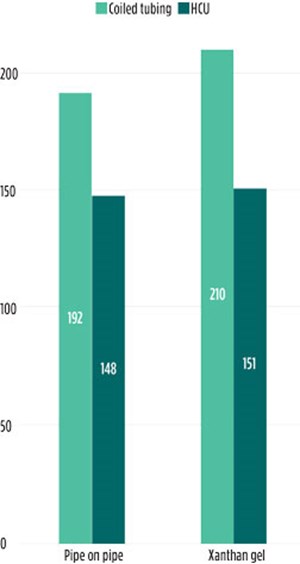
Reduced NPT. The ability to rotate and remove solids from the wellbore also reduced the sticking issues experienced with CTUs. Sticking resulted in a significant amount of NPT for the CTU, whether it can pull free or it needs to be cut and fished from the well. The reduction of solids in the wellbore led an overall decrease in NPT when comparing the HCU versus the CTU, which can be seen in Fig. 3.
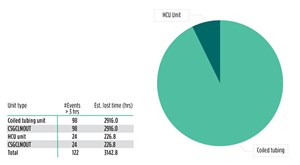
Although there were two to three CTUs running during the year, as compared to one HCU, the ratio of events is ~4:1, and total number of hours is well over 10:1. The longest NPT events are when the CTU becomes stuck and cannot work the tubing free. There were three occasions throughout 2019 that coiled tubing became stuck during a frac plug drill-out, and it had to be cut and fished by a workover rig. In 2019, the HCU became stuck once, in which pipe had to be cut. The benefit of the HCU was that the unit was able to fish and retrieve the workstring without moving off the well or calling out another unit.
In the early implementation stages, the HCU was used across the entire basin. There is a wide variety of pressure profiles across the Permian basin that provide better conditions for different unit types. As the HCU was trialed in various fields and formations, it became clear that it excelled in particular fields, generally those with higher pressures. Higher pressure here is defined as surface pressure greater than 1,000 psi. Other differentiators of the HCU from the CTU were the depth and downhole complexity of the wells.
Wells in Lea County tend to be deeper than other areas of the field, with target formations at +/-12,000 ft, TVD, that are over-pressured while having lateral lengths similar to the rest of the basin. These conditions make it difficult for coiled tubing to drill-out these wells with the deeper or higher pressures. Other parts of the basin have added downhole complexity, due to reservoir depletion and cross-flows. These depleted areas with cross-flows have been seen in certain sections of Eddy County and have caused differential sticking problems. The ability to rotate the workstring reduces the likelihood of getting stuck during these crossflow events.
Consideration of the above scenarios led to a more focused implementation strategy for the HCUs and CTUs. While the HCU has the ability to drill-out successfully in each of the fields in the Permian, there are more complex fields that are exclusive to the HCU application. These fields can be seen in Fig. 4, which shows wells in Lea County were only drilled out by the HCU, due to the complexities mentioned previously. Also, there was a large decrease in average days to drill-out in Eddy County when comparing the HCU to the CTU. Use of the CTU was targeted for the more developed and less complex fields.
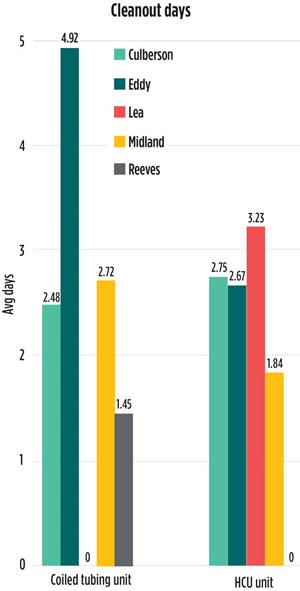
Additional efficiencies. As mentioned, another benefit of the HCU is the ability to drill-out and install the downhole completion equipment without moving off the well or bringing in a workover unit. This eliminates the need to rig up a workover unit to run production tubing and artificial lift. The HCU has successfully run tubing, ESPs, gas lift mandrels, and a control line through the unit.
This operation required a slight modification to the work window, which was done prior to bringing on the unit. Being able to do this without moving the unit off the well eliminates the rig-up and rig-down time of a workover unit and the cost of extra rental equipment, along with reducing the number of custody transitions, which are areas for increased risk in knowledge transfer. This advantage, alone, decreased the tubing installation phase by more than half, from 1.8 days/well down to 0.74 days/well. This can be observed in Fig. 5, which equates to ~$60,000 in savings per well, a 16% increase in efficiency, and in turn, the ability for wells to start producing at an earlier date.
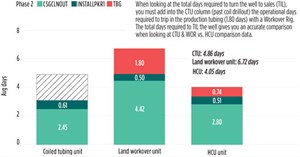
CONCLUSION
Implementation of HCUs into the Permian Basin has resulted in significant improvements in drill-out metrics in many applications. The addition of pipe rotation has decreased the need for chemicals by almost one-third of the volume, and with the HCU’s ability to install production equipment directly after drilling out the frac plugs has reduced the time from drill-out to initial production by 16%. This new completion technology has proven to be a viable and cost-effective option to drill-out frac plugs in high pressure and extended reach lateral wells.
- Shale technology: Bayesian variable pressure decline-curve analysis for shale gas wells (March 2024)
- Using data to create new completion efficiencies (February 2024)
- Digital completions platform provides complete operations visibility to enhance efficiency, collaboration (December 2023)
- Delivering a full range of innovative well completion technologies (September 2023)
- Combining video and ultrasound increases downhole data capture accuracy (May 2023)
- EOR/IOR technology: Advanced shale oil EOR methods for the DJ basin (May 2023)
- Applying ultra-deep LWD resistivity technology successfully in a SAGD operation (May 2019)
- Adoption of wireless intelligent completions advances (May 2019)
- Majors double down as takeaway crunch eases (April 2019)
- What’s new in well logging and formation evaluation (April 2019)
- Qualification of a 20,000-psi subsea BOP: A collaborative approach (February 2019)
- ConocoPhillips’ Greg Leveille sees rapid trajectory of technical advancement continuing (February 2019)

